Massoud M. Engineering Thermofluids: Thermodynamics, Fluid Mechanics, and Heat Transfer
Подождите немного. Документ загружается.


612 Va. Two-Phase Flow and Heat Transfer: Two-Phase Flow Fundamentals
a) We find the parameter y from:
y = [(1 – X)/X](
ρ
g
/
ρ
f
) = (0.7/0.3)(39/732) = 0.124
β
= 1/(1 + y) = 1/(1 + 0.124) = 0.89
Next, we calculate V
gj
From Equation Va.2.5 and then find J,
α
, and S:
V
gJ
= 1.41[g(
ρ
f
–
ρ
g
)
σ
/
2
f
ρ
]
0.25
= 1.41[9.81 × (732 – 39) × 0.0166/732
2
]
0.25
= 0.17
m/s
J = (1 + y)XG/
ρ
g
= (1 + 0.124) × 0.3 × 4000/39 = 34.58 m/s
α
=
β
/[C
o
+ V
gJ
/J] = 0.89/[1.13 + 0.17/34.58] = 0.78
(Compare with
α
ΗΕΜ
=
β
= 0.89)
S =
»
¼
º
«
¬
ª
××
×
+
»
¼
º
«
¬
ª
−
+
40003.0124.0
17.039
124.0
113.1
13.1
= 2.2
b) For the mixing cup density we need phasic velocities. We find V
g
and V
f
from
J
g
and J
f
:
V
g
= J
g
/
α
= G
g
/
αρ
g
= XG/
αρ
g
= 0.3 × 4000/(0.78 × 39) = 39 m/s
V
f
= (1 – X)G/(1 –
α
)
ρ
f
= (1 – 0.3) × 4000/[(1 – 0.78) × 732] = 17.4 m/s
(Note; S = V
g
/V
f
= 2.2)
1/
ρ
’ = [39 × 0.78 × 39.25
2
+ 732 × (1 – 0.78) × 17.38
2
]/4000
2
= 5.97E-3 m
3
/kg
Thus,
ρ
’ = 167.5 kg/m
3
. Find mixture density from:
ρ
= (1 –
α
)
ρ
f
+
αρ
g
= (1 – 0.78) × 732 + 0.78 × 39 = 191.46 kg/m
3
c) The HEM density is obtained by substituting related values for specific vol-
umes;
v = (1 – X)v
f
+ Xv
g
. Thus,
ρ
HEM
= (1 – X)/
ρ
f
+ X/
ρ
g
= (1 – 0.3)/732 + 0.3/39 =
115.6 kg/m
3
.
d) Since we have used saturation properties, we have implicitly assumed thermal
equilibrium exists between the phases hence, x = X = 0.3.
Whalley uses the definition of slip velocity to express drift flux in terms of void
fraction as:
J
gf
= V
b
α
(1 –
α
)
2
Va.2.6
where V
b
is the rising velocity of a single bubble as a function of pressure (Ta-
ble Va.2.1).
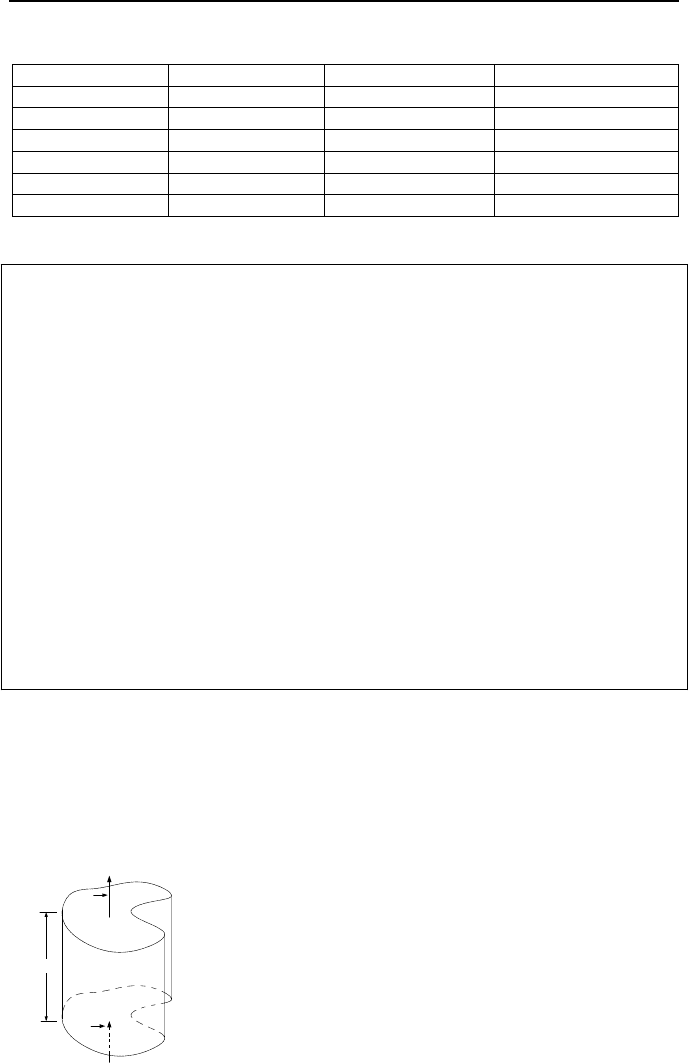
2. Two-Phase Flow Relation 613
Table Va.2.1. Values of V
b
for water-steam flow (Whalley)
P (bar) V
b
(m/s) P (psia) V
b
(ft/s)
1 0.22 14.5 0.722
3 0.21 43.5 0.689
10 0.20 145 0.656
30 0.19 435 0.623
100 0.16 1450 0.525
221.2* 0.0 3207.4* 0.00
*: At critical pressure
ρ
g
ĺ
ρ
f
,
σ
ĺ 0, and V
b
ĺ 0
Example Va.2.6. A mixture of water and steam flows up a 10 mm diameter tube
at a rate of 4000 kg/s⋅m
2
and 2 kg/s⋅m
2
, respectively. Assume an adiabatic condi-
tion. Find void fraction in the tube.
Data: P = 1 atm,
ρ
f
= 1000 kg/m
3
,
ρ
g
= 0.598 kg/m
3
.
Solution: One way to find
α
is to set Equation Va.2.5 equal to the definition of J
gf
= (1 –
α
)J
g
–
α
J
f
:
V
b
α
(1 –
α
)
2
= J
gf
= (1 –
α
)J
g
–
α
J
f
We now need J
f
and J
g
, which are calculated as:
J
f
= G
f
/
ρ
f
= 4000/1000 = 4 m/s
J
g
= G
g
/
ρ
g
= 2/0.598 = 3.34 m/s
Finding V
b
from Table Va.2.1 as 0.22 m/s, one obtains the following non-linear
equation for
α
:
(J
f
+ J
g
)
α
+ V
b
α
(1 –
α
)
2
– J
g
= 0
By iteration, we find
α
§ 0.455.
2.3. Conservation Equations
Derivation of conservation equations for multi-phase and multi-dimensional flow
in a control volume with a deformable boundary is beyond the scope of this book.
Here, we consider a one-dimensional two-phase flow in a fixed boundary control
volume with constant flow area, as shown in Figure Va.2.1 (Myer). To write the
∆s
A
A
V
V
∆V
Figure Va.2.1. One-dimensional control volume for conservation equations
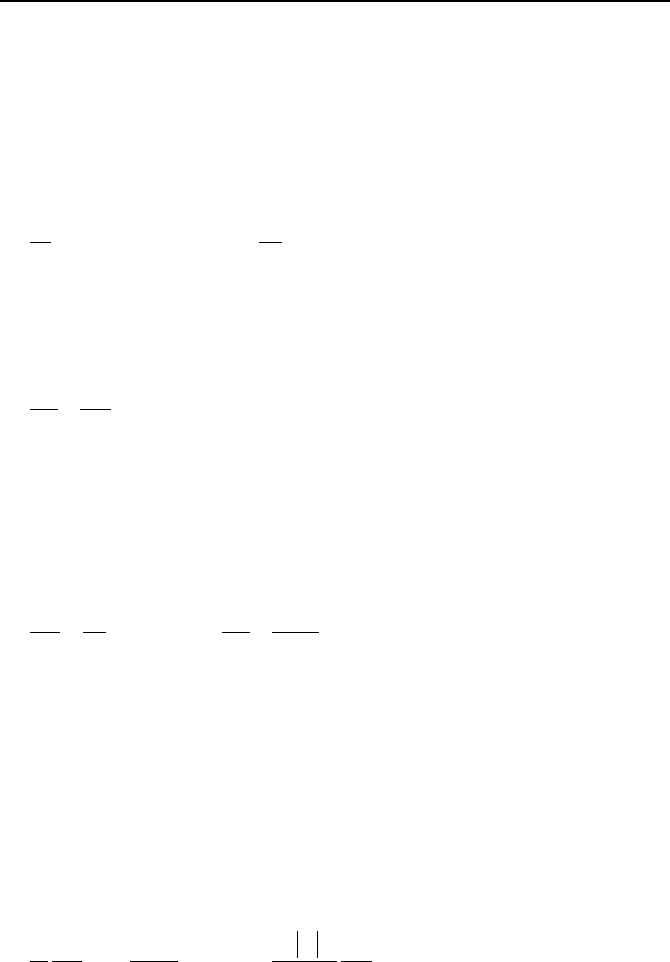
614 Va. Two-Phase Flow and Heat Transfer: Two-Phase Flow Fundamentals
conservation equation for the mixture, we use volume-averaged quantities similar
to Equation Va.2.2, defined for void fraction. Since the flow area is assumed to be
constant, the area averaged value for any quantity such as
ψ
is simplified to
³
>=< AdA /)(
ψψ
.
Beginning with the conservation equation of mass, we apply Equation IIIa.3.2
to the two-phase flow in the elemental control volume of Figure Va.2.1. We then
divide each term by A∆z and let ∆z approach zero:
0)1()1( >=+−<
∂
∂
+>−+<
∂
∂
αραραραρ
ggfffg
VV
s
t
Va.2.7
If we now substitute for the mixture density,
ρ
= (1 –
α
)
ρ
f
+
αρ
g
and the mixture
mass flux, defined as; G = <
ρ
f
(1 –
α
)V
f
+
ρ
g
a>, the one-dimensional continuity
equation for the flow of a two-phase mixture becomes:
0=
∂
∂
+
∂
∂
s
G
t
ρ
Va.2.8
If Equation Va.2.8 is integrated over a macroscopic control volume V = sA, we
obtain Equation IIa.5.1.
Regarding the one-dimensional conservation equation of momentum for two-
phase flow in a constant area channel, we use Equation IIIa.3.6. Assuming gravity
to be the only body force and substituting for the shear stresses, such as surface
force, we find the momentum equation for uniform flow at a cross section z:
γρ
τ
sin
P
v
2
g
A
s
P
G
s
t
G
sw
−−
∂
∂
−>=
′
<
∂
∂
+
∂
∂
Va.2.9
where
τ
s
is the shear stress at the wall of the channel, P
w
is the channel wetted pe-
rimeter, and
ρ
’ = 1/v’ is the mixing cup density. Also note that
γ
is the angle be-
tween the flow velocity vector and the horizontal plane (see Figure Va.2.2) and
ranges from –
π
/2
≤
γ
≤
π
/2. For horizontal channels
γ
= 0. For vertical channels, if
flow is upward,
γ
=
π
/2 and if flow is downward,
γ
= –
π
/2.
The term representing shear stresses in Equation Va.2.9 can be substituted from
Equation IIIb.2.5 for single-phase flow so that P
w
τ
s
/A = fv|G|G/2D
h
where f is the
friction factor and using the absolute value of G ensures opposing force in the case
of flow reversal in the channel. To obtain the momentum equation for a macro-
scopic control volume, we integrate Equation Va.2.9 over a finite length s:
γρ
sinV
2
v
v
22
2
g
D
s
A
mmf
P
A
m
dt
md
A
s
m
h
−−∆−=
¸
¸
¹
·
¨
¨
©
§
′
∆+
Va.2.10
The two-phase flow momentum equation is discussed in more detail in Sec-
tion 2.4.
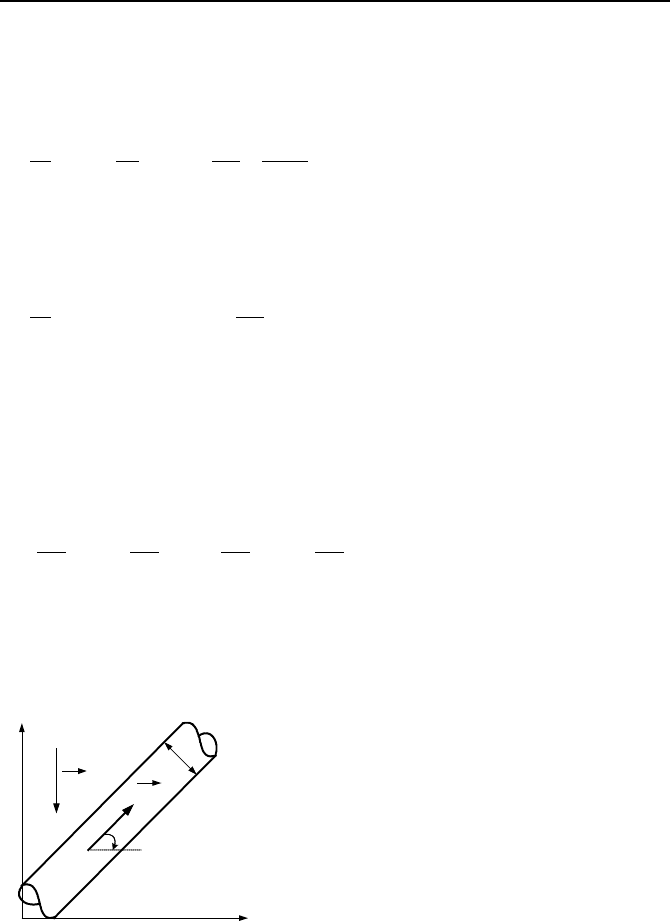
2. Two-Phase Flow Relation 615
The conservation equation of energy for two-phase flow in a constant area
channel can be derived from Equation IIIa.3.9 with work terms substituted from
Equation IIIa.3.10. Ignoring the contribution by kinetic and potential energies and
considering only pressure work, the energy equation simplifies to:
q
A
q
s
P
Gh
s
h
t
h
′′′
+
′′
+
∂
∂
=
∂
∂
+
∂
∂
P
)'()(
ρ
Va.2.11
where the mixture density h represents h = <
ρ
f
h
f
(1 –
α
) +
ρ
g
h
g
α
>/
ρ
and h’ is the
mixing cup enthalpy. To obtain the energy equation for a macroscopic control
volume, we integrate Equation Va.2.11 over control volume V = sA:
VPV)()V( qsq
s
P
hmh
t
h
′′′
+
′′
+
∂
∂
=
′
∆+
∂
∂
ρ
Va.2.12
2.4. Pressure Differential Terms
Equation Va.2.10 includes five pressure differential terms for two-phase flow
which are similar to the pressure differential terms for single-phase flow defined
in Equation IIIa.3.43 (with ∆P
shaft
= 0). At steady state, ∆P
Inertia
= 0 and Equa-
tion IIIa.3.43 simplifies to:
0)()()()( =+++
gravfricaccstat
ds
dP
ds
dP
ds
dP
ds
dP
Va.2.13
where the terms are differentiated with respect to s, the element of length as
shown in Figure Va.2.2, not to be confused with the slip ratio, S. Let’s now evalu-
ate each term in Equation Va.2.13.
x
y
F
lo
w
γ
V
s + ds
d
s
s
g
D
Figure Va.2.2. Steady-state flow of a two-phase mixture in a pipe
Static pressure gradient, (dP/ds)
stat
if integrated over a finite length in the
flow path gives the total pressure drop from inlet (point i) to exit (point e):

616 Va. Two-Phase Flow and Heat Transfer: Two-Phase Flow Fundamentals
µ
¶
´
−=
¸
¹
·
¨
©
§
e
i
ie
stat
PPds
ds
dP
. Va.2.14
Pressure gradient due to acceleration is given by:
)(
])[(
1
)(
1
)(
2
ρ
ρ
′
===
G
ds
d
ds
VVAd
Ads
Vmd
Ads
dp
acc
Va.2.15
The derivative can be carried out based on the simplification made for the mixing
cup density. For example, if velocities of both phases are uniform across the
channel, we may substitute for V
g
and V
f
from V
g
= G
g
/
αρ
g
= XG/
αρ
g
and V
f
= (1 –
X)G/(1 –
α
)
ρ
f
in the relation for mixing cup density to get;
gf
XX
αρραρ
22
)1(
11
+
−
−
=
′
Va.2.16
Substituting for
ρ
’ from Equation Va.2.16 into Va.2.15 and carrying out the de-
rivative, we find:
222
22
22
2
2
2(1 ) v 2 v (1 ) v v
() [ ]() [ ]()
(1 ) (1 )
v
[]()
fg fg
acc
g
XX XX
dP dX d
GG
ds ds ds
XdP
G
Pds
α
αα αα
α
−−
=− + + + +
−−
∂
∂
Va.2.17
This derivation applies to separated flow. For HEM, the mixing cup density is
calculated from 1/
ρ
’ = v = (1 – X)v
f
+ Xv
g
. Substituting this relation in Equa-
tion Va.2.15 and using the equal phase velocity assumption, we get:
]v
v
[]vv[)(
22
ds
dX
ds
dP
P
X
ds
d
GX
ds
d
G
ds
dP
fg
fg
fgfacc
+
∂
∂
=+=
Va.2.18
Neglecting the compressibility of liquid (i.e., setting ∂v
f
/∂P = 0), we find
(dP/ds)
acc
for HEM as:
]v
v
[)(
2
ds
dX
ds
dP
P
XG
ds
dP
fg
g
acc
+
∂
∂
=
Va.2.19
Pressure gradient due to friction for two-phase flow is similar to friction
pressure drop for single-phase flow. For example, suppose a mixture of water and
steam is flowing in a heated pipe of diameter D and length L at the mass flow rate
of
m
. The friction pressure drop for the two-phase mixture is obtained from:
2
2
2 A
m
D
L
fP
tp
tptp
ρ
=∆ Va.2.20(a)
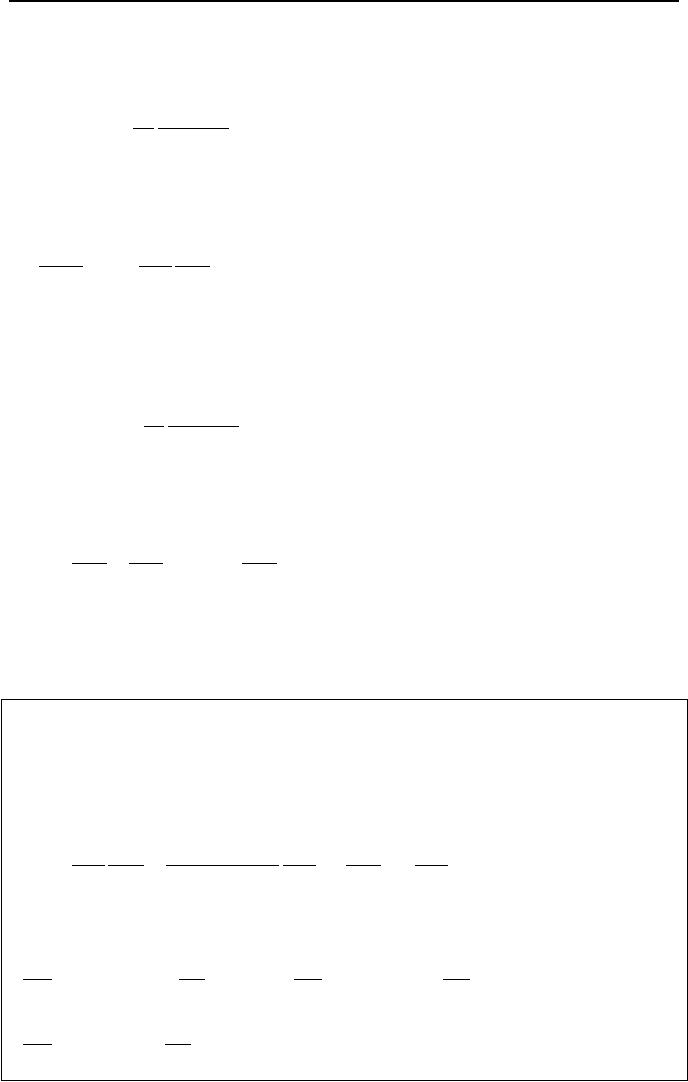
2. Two-Phase Flow Relation 617
where subscript tp stands for two-phase. To find f
tp
, we now assume a case that
only water is flowing in the same pipe at the same mass flow rate as the mixture of
water and steam:
2
2
2 A
m
D
L
fP
sp
spsp
ρ
=∆ Va.2.20(b)
where sp stands for single-phase, hence,
ρ
sp
=
ρ
f
. Dividing Equation Va.2.20(a)
by Va.2.20(b) we get:
tp
sp
sp
tp
sp
tp
f
f
P
P
ρ
ρ
φ
==
∆
∆
Va.2.21
This ratio is referred to as the two-phase friction multiplier. Substituting for f
tp
/
ρ
tp
=
φ
(f
sp
/
ρ
sp
) from Equation Va.2.21 in Equation Va.2.20(a), we find the two-phase
friction pressure drop as:
2
2
2 A
m
D
L
fP
sp
sptp
ρ
φ
=∆ Va.2.22
For homogeneous equilibrium conditions assuming f
tp
= f
sp
, the two-phase friction
multiplier becomes:
]
v
v
1[
v
v
f
fg
sp
tp
tp
sp
X+===
ρ
ρ
φ
Va.2.23
This derivation was for a heated pipe. If the mixture is flowing in a pipe that is
being cooled resulting in steam condensation, the comparison is made with only
steam flowing in the pipe (i.e.,
ρ
sp
=
ρ
g
).
Example Va.2.7. Derive alternative relations for the two-phase friction multi-
plier.
Solution: Rather than assuming equal single-phase and two-phase friction fac-
tors, let’s substitute for friction factors in turbulent flow from Equation IIIb.3.6.
In this case, Equation Va.2.23 becomes:
sp
tp
sp
tp
sp
tp
sp
tp
tp
sp
sp
tp
f
f
v
v
)(
v
v
Re/184.0
Re/184.0
2.0
2.0
2.0
µ
µ
ρ
ρ
φ
===
The two-phase to single-phase viscosity ratio may be evaluated based on correla-
tions by McAdams, Cichitti, or Duckler:
1
() [1 ( 1)];() [1 ( 1)];
() [1( 1)]
tp f tp g
McAdam Cichitti
sp g sp f
tp g
Dukler
sp f
XX
µµµµ
µµµµ
µµ
β
µµ
−
=+ − =+ −
=+ −

618 Va. Two-Phase Flow and Heat Transfer: Two-Phase Flow Fundamentals
Reddy has recommended a relation similar to Equation Va.2.23:
CX
ffg
)v/v(1 +=
φ
Va.2.24
where C = C’X
–0.175
G
–0.45
. If P > 600 psia then C’ = 1.02 otherwise, C’ = 0.357[1
+ (P/P
critical
)]. In this relation, mass flux G, is in Mlbm/ft
2
·h. This correlation is
valid for vertical upflow in tubes of 0.2 to 0.6 inches in diameter and 5 to 100
inches in length. The range for mass flux is 0.35 to 3.3 Mlbm/ft
2
·h. The advan-
tage of Reddy’s correlation is that it also accounts for the effect of mass flux.
A more recent correlation based on a vast bank of data is suggested by Friedel:
035.0045.0
32
1
WeFr
24.3 CC
C +=
φ
where Fr and We are the Froude and Weber numbers. The Froude number, the ra-
tio of inertial to gravity force (Table A.I.6) is given as:
gD
m
gL
V
2
2
Fr
ρ
==
and the Weber number, the ratio of inertial to surface tension force, is given as:
ρσσ
ρ
DGG
VD
gf
2
2
)(
We
+
==
where
ρ
= 1/v = v
f
+ Xv
fg
. Constants C
1
, C
2
, and C
3
are related to steam quality
and two-phase properties:
fsp
gsp
g
f
f
f
XXC
,
,
22
1
)1(
ρ
ρ
+−= ,
24.078.0
2
)1( XXC −= , and
7.019.091.0
3
1
¸
¸
¹
·
¨
¨
©
§
−
¸
¸
¹
·
¨
¨
©
§
¸
¸
¹
·
¨
¨
©
§
=
f
g
f
g
g
f
C
µ
µ
µ
µ
ρ
ρ
Calculating the two-phase friction multiplier from any of the above relations, the
frictional pressure gradient, (dP/ds)
fric
, from Equation Va.2.22 can therefore be
expressed as:
sp
spfric
G
D
f
ds
dP
ρ
φ
2
1
)(
2
= Va.2.25
Pressure gradient due to gravity is given by:
)]v/v(1[v
sin
sin
v
1
sin)(
ffgf
grav
X
g
gg
ds
dP
+
===
γ
γγρ
Va.2.26
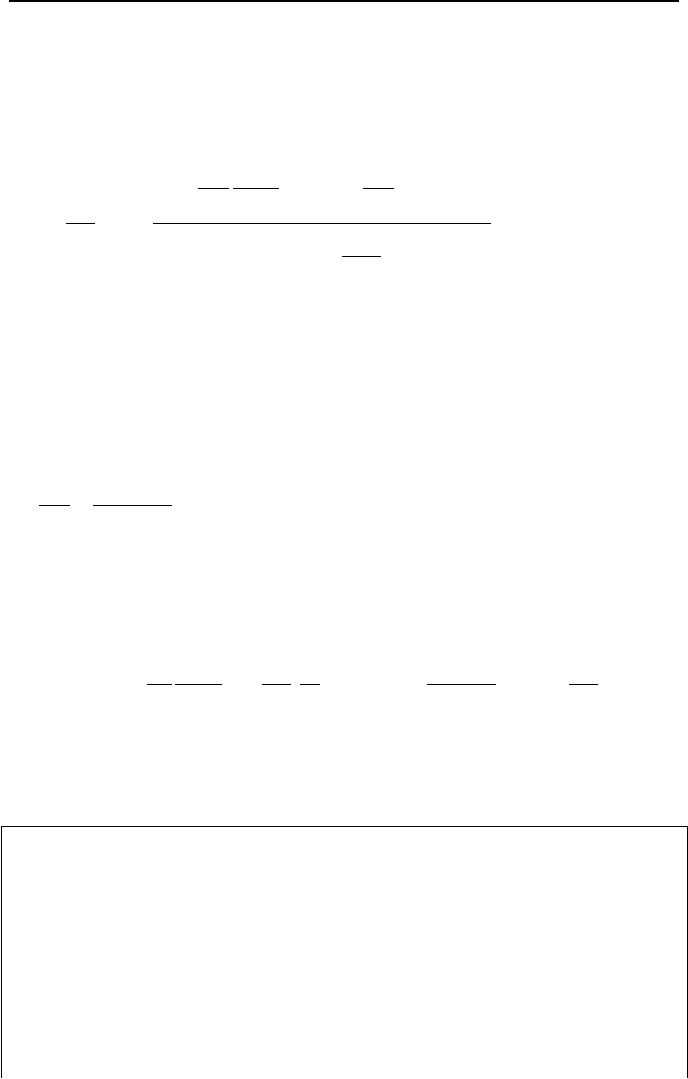
2. Two-Phase Flow Relation 619
2.5. Static Pressure Gradient, HEM
We now can find (dP/ds)
stat,HEM
if we substitute for various pressure gradient terms
into Equation Va.2.13. The result depends on whether we use Equation Va.2.17
or Va.2.19 to represent (dP/ds)
acc
. If we use Equation Va.2.19, which is applica-
ble to HEM, we find:
P
XG
g
ds
dX
G
G
D
f
ds
dP
g
fg
sph
sp
stat
∂
∂
+
++
=
¸
¹
·
¨
©
§
−
v
1
cosv
2
1
2
2
2
γρ
ρ
φ
Va.2.27
where
φ
for HEM is given by Equation Va.2.23. We also used D
h
so that Equation
Va.2.15 is applicable to channels other than pipes and tubes. We may now inte-
grate Equation Va.2.27 for the special case of a uniformly heated channel of
length L and hydraulic diameter D
h
. At the channel inlet (i) we have s
i
= 0 and at
the channel exit (e) we have s
e
= L. In this integration, we assume saturated sin-
gle-phase liquid enters the channel (i.e., X
i
= 0). Since the channel is heated uni-
formly, we can make a change of variable from s to X according to:
L
XX
ds
dX
ie
−
=
so that ds = (L/X
e
)dX. Note that the gas compressibility is generally very small,
|v
g
/ P| << 1, which greatly simplifies the integration of Equation Va.2.27. Re-
placing
ρ
with
ρ
= [v
f
+ Xv
fg
]
–1
and assuming that f
sp
and v
fg
/v
f
remain constant,
we integrate Equation Va.2.15 from the inlet to any point along the channel:
2
2
vv v
cos
( ) [1 ( ) ] v ln[1 ( )]
2v2 v v
ffg fg
isp fg
ef fg f
G
LXgL
PP f G X X
DX
γ
−= + + + +
Va.2.28
where the quality and thermodynamic properties are evaluated at system pressure
and D
e
= D
h
is the equivalent hydraulic diameter.
Example Va.2.8. Water at 70 bar, 210 C, and a mass flow rate of 0.1 kg/s enters a
uniformly heated vertical tube of diameter 2 cm and length 4 m. The applied heat
flux is 600 kW/m
2
. Find a) length of the tube over which water remains sub-
cooled, b) pressure drop for the subcooled section, and c) total pressure drop.
Solution: At P = 70 bar; T
sat
= 285.9 C, h
f
= 1267 kJ/kg, h
fg
= 1505 kJ/kg. h
i
(70
bar & 210 C) ≅ 900 kJ/kg.
a) Since T
i
< T
sat
, subcooled water enters the heated channel. The length of the
single-phase or pre-heating section is found from a heat balance:
)()(
iff
hhmdLq −=
′′
π
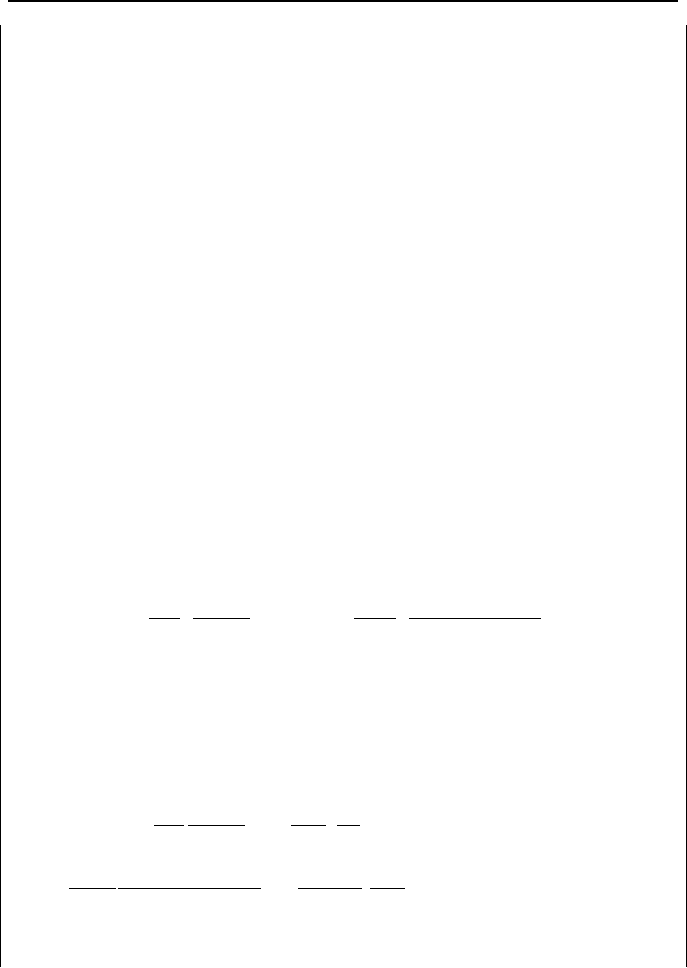
620 Va. Two-Phase Flow and Heat Transfer: Two-Phase Flow Fundamentals
Substituting values: 600[
π
× (2/100) × L
f
)] = 0.1[1267 – 900]
Solving for L
f
, we find: L
f
≅ 1 m.
Water then boils over the remaining 3 m of the tube. To find the exit quality we
write the energy balance over the boiling length:
600[
π
× (2/100) × (L – L
f
)] = 0.1[h
e
– 1267]
Substituting values we find: h
e
= 2398 kJ/kg
X
e
= (h
e
– h
f
)/h
fg
= (2398 – 1267)/1505 = 0.75
b) Over the single-phase section, we find pressure drop due to friction, accelera-
tion, and gravity:
At T
sat
= 285.9 C; v
f
= 0.00135 m
3
/kg, v
fg
= 0.026 m
3
/kg,
µ
f
= 0.943E-4 N·s/m
2
Tube flow area is: A
f
=
π
× 0.02
2
/4 = 3.14E-4 m
2
Thus, the mass flux is: G = 0.1/3.14E-4 = 318.3 kg/m
2
·s
(P
i
– P
e
)
fric
= )2/(v)/(
22
ffefsp
AmDLf
To find f
sp
, we must calculate the Reynolds number:
Re
sp
= ADm
e
µ
/
= 0.1 × 0.02/[0.943E-4 × 3.14E-4 = 67,510 (Flow is turbulent)
f
sp
= 0.184/Re
0.2
≅ 0.0199
The friction pressure drop over the single-phase section is found as:
(∆P)
fric,sp
=
2
2
2
v
f
f
e
f
sp
A
m
D
L
f
¸
¸
¹
·
¨
¨
©
§
=
8E87.92
1.000135.0
02.0
1
0199.0
2
−×
×
¸
¹
·
¨
©
§
= 0.068 kPa
(∆P)
acc,sp
= G
2
(v
f
– v
i
) = (318.3)
2
× (0.00135 – 0.00117) = 0.018 kPa
(∆P)
grav,sp
= gL
f
cos
β
/[(v
i
+ v
f
)/2] = 9.81 × 1/[(0.00117 + 0.00135)/2] = 7.8 kPa.
c) We now find pressure drop due to friction, acceleration, and gravity over the
two-phase section using the homogenous model:
=+=∆ ]
2
)
v
v
(1[
2
v
)(
2
,
X
G
D
L
fP
f
fgf
e
b
sptpfric
2
(4 1) (318.3) 0.00135 0.026 0.75
0.0199 [1 ( ) ] 1.68 kPa
0.02 2 0.00135 2
−×
+=
22
,
( ) v (318.3) 0.026 0.75 1.97 kPa
acc tp fg
PGX∆= = ××=
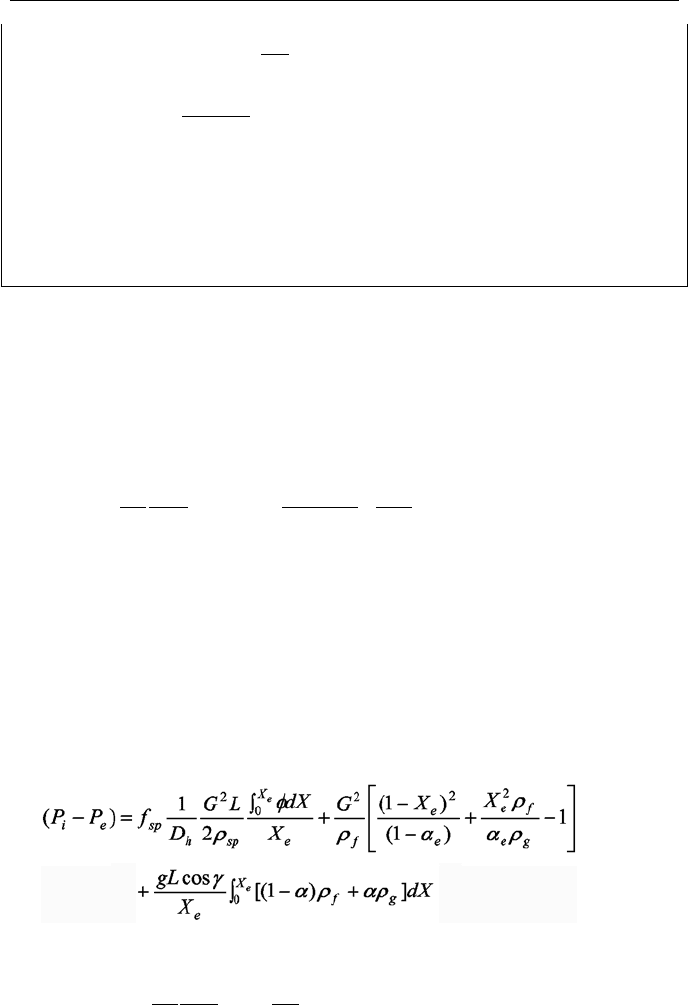
2. Two-Phase Flow Relation 621
,
v
() cosln[1 ( )]/(v )
v
0.026
9.81 3 ln[1 0.75( )]/(0.026 0.75) 4.1 kPa
0.00135
fg
grav tp b fg
f
PgL X X
γ
∆= + =
×× + × =
∆P
total
= (0.068 + 1.68) + (0.018 + 1.97) + (7.8 + 4.1) = 15.6 kPa
Comment: Calculation of the properties at the inlet pressure is a reasonable as-
sumption in this problem since the pressure drop is a small percentage of the inlet
pressure (≈ 0.2%). In general, an iterative solution may be required to find
properties at an average pressure.
2.6. Static Pressure Gradient, Separated Flow Model (SFM)
To obtain (dP/ds)
stat
for the separated flow model, we substitute for various pres-
sure gradient terms into Equation Va.2.13. For (dP/ds)
acc,
we substitute from
Equation Va.2.17. If we integrate the resulting equation between the channel inlet
at s
i
= 0 and any location along the channel, we find the gradient for static pressure
as:
³
³
s
s
gf
X
X
gf
s
s
sph
spi
i
i
i
dsg
X
X
Gds
G
D
fPP ])1[(sin
)1(
)1(
2
1
)(
22
2
2
αρραγ
αρρα
φ
ρ
+−+
»
»
¼
º
«
«
¬
ª
+
−
−
+=−
Va.2.29
The acceleration pressure drop, being a perfect differential, depends only on the
end points and is independent of the flow path. Expressing mixture property
variations as a function of s, we can integrate the first and the third terms of Equa-
tion Va.2.29. Similar to the case of HEM, for a special case of uniformly heated
channel, a change of variable can be introduced by replacing the differential
length, ds, with dX, the differential quality. Substituting the change of variable
into Equation Va.2.29, for the special case of uniformly heated channels with X
i
=
α
i
= 0, we find:
This equation can alternatively be written as:
22
12 3
1
() ()() sin()
2
ie sp f
hsp f
GL G
PP f C C gL C
D
ρβ
ρρ
−= + +
Va.2.30
